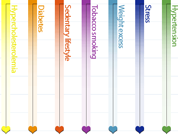Once the intervention has been performed, you are monitored for a further 12 to 24 hours in an intermediary or intensive care unit. In fact, your heart is still in a high risk phase, particularly for arrhythmias. In this unit, the staff is trained and equipped to deal with these risks and to act accordingly. Because of bleeding risks, you will be asked to bend your leg or your arm, depending on where the catheter was inserted.
After this monitoring period, you will be transferred to hospital ward. Monitoring is continued in a less intensive manner and treatment is adapted to your needs. It is in this hospital ward that you will be made aware of what led to your health problems (your risk factors) and the various treatments and medications that will be offered to you.
Further investigations will be carried out to verify your heart function and detect complications related to the heart attack:
- echocardiography (non-invasive and painless exam)
- stress test (usually on a bicycle)
No lying about!
You will begin a first phase of cardiac rehabilitation with a physiotherapist on the same day of your arrival in the ward. This rehabilitation will take place progressively and will take your overall condition into account. Before you leave, we will suggest that you continue with an ambulatory cardiac rehabilitation programme. This programme is fully reimbursed by health insurance and it is highly recommended.
Then there is the day for hospital discharge. The medical staff considers you to be fit to return home. At this stage, your medication has been adapted but there may still be some small adjustments to be made. A prescription and treatment card will be given to you, as well as an appointment to begin the cardiac rehabilitation programme.
